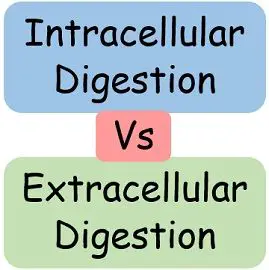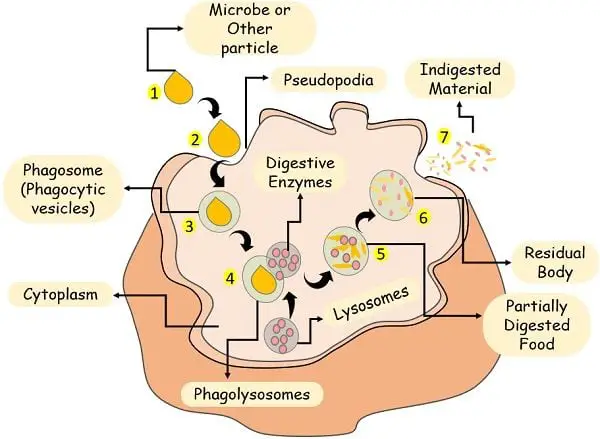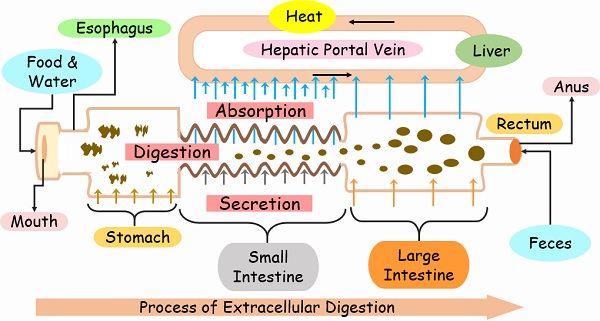The digestion process varies according to the level of complexity of the organisms. Living organisms exhibit two different methods of digesting food- intracellular and extracellular digestion.
Single-celled organisms that lack proper channels to extract the nutrients from the taken food perform intracellular digestion. Here, the process of digestion occurs inside the cell, thus we refer to it as intracellular. It is the most primitive and simple digestion method as it doesn’t involve numerous organs and complex enzyme actions.
On the other side, extracellular digestion is an advanced and complex mechanism with multiple steps and specified organs to carry out a specific function. Basically, we refer to it as extracellular because it occurs outside the cell. The multicellular organism with a well-defined digestive tract and enzymes exhibits an extracellular type of digestion.
Here, we will discuss the basic differences between intracellular and extracellular digestion in detail.
Content: Intracellular Vs Extracellular Digestion
- Comparison Chart
- What is Intracellular Digestion?
- What is Extracellular Digestion?
- Key Differences
- Summary
Comparison Chart
| Basis of Comparison | Intracellular Digestion | Extracellular Digestion |
|---|---|---|
| Definition | It refers to the type of digestion where the ingested material is broken down into smaller components inside the cell itself. | This digestion process occurs when the breakage of ingested material occurs outside the cell. |
| Occurrence | Takes place in the food vacuoles of cell. | It takes place outside the cell, i.e., in the lumen area of the alimentary canal or on the dead decaying organic debris (in the case of fungi). |
| Explanation | It is a primitive method that occurs in the lower animals that lack the digestive system and the related enzymes. | It is an advanced and sophisticated method in higher organisms with a well-defined digestive tract with all the necessary enzymes. |
| Methods of Ingestion | Here, the ingestion is via phagocytic vesicles. | Here, the ingestion occurs through the mouth. |
| Involvement of Digestive enzymes | These enzymes in the lysosomes get secreted into the food vacuole. | Here, specialized alimentary canal glands release the digestive enzymes into the lumen. |
| Mode of Digestion | Only chemical digestion is possible here. | Both mechanical and chemical form of digestion occurs. |
| Distribution and absorption of Nutrients | The nutrients extracted from the digested food directly diffuse into the cytoplasm. | Here, the digestive products get absorbed into the bloodstream via the gut epithelia or the intestinal wall. |
| Complexity of mechanism | It is a simple mechanism. | It is quite a complex procedure as it involves many components. |
| Found in | Lower organisms, mainly protozoans like an amoeba. | Both lower and higher organisms, from bacteria to animals and humans. |
| Efficiency | Less efficient | More efficient |
| Regional Differentiation | No regional distribution as they lack the organs and specific organ systems. | Various specified organs are present at different locations; this leads to the regional distribution of the digestion process. |
| Process | The process occurs inside the cell, where the food vacuole fuses with lysosomes containing hydrolytic enzymes to break down the food. | This form of digestion occurs outside the cells in the compartments or tracts that move continuously to the body. |
| Presence of vesicles | Vesicles are involved. | Vesicles are not required. |
What is Intracellular Digestion?
Intracellular refers to the digestion that occurs inside the cell. Here, the food material comes inside the cell and gets broken down into smaller components with the help of enzymes. This digestion is totally a chemical type of digestion.
The cell ingests the food through phagocytosis, which remains in the food vacuole. Later the lysosomes secrete the digestive enzymes onto the food vacuole. The enzymes start acting over the food particles, thereby converting them into absorbable form for the cell.
After completion of the chemical digestion, the extracted nutrients directly get diffused into the cytoplasm via the vacuolar membrane.
Which cellular organelle aids intracellular digestion?
The most significant organelle for this digestion is lysosomes. These serve the role of storage bags to store the digestive enzymes.
The lysosomes are membrane-bound entities that are a rich source of the hydrolytic chemical responsible for the breakdown of food particles. Thus, we can say that they are the centre for cellular digestion.
They basically have an acidic environment as it is essential for the optimal functioning of the hydrolytic enzymes.
This acidic atmosphere also supports the lysosomes to maintain their integrity and prevents the hydrolytic chemicals from self-digestion of them. If there is any rupture in the lysosome membrane, this can lead to the loss of its integrity.
In such a case, the hydrolytic enzymes will be secreted directly into the cytoplasm causing cellular death.
Process of Intracellular Digestion
- Due to chemotaxis, a microbe or any other food particle comes closer to the cell.
Note: The movement of any entity in reaction to a chemical stimulation is chemotaxis.
- The food particles adhere to the phagocyte.
- Further, the phagocyte ingests the food, which forms a food vacuole called a phagosome.
- The phagosome combines with the lysosome, which gives rise to phagolysosomes.
- Now, the digestion of the ingested food occurs inside the phagolysosome by enzymes.
- After completing the digestion process, the cell produces residual bodies. They contain the undigested material to throw out.
- At last, the cell disposes off the undigested residues.
- And the digested nutrients diffuse in the cytoplasm.
Importance of Intracellular Digestion
In the lower organisms like single-celled protozoans, this type of digestion is the only way by which they can get the nutrients for their survival.
They lack a proper digestive pathway; thus, this primitive but simplified way of digestion aids the supply of energy with minimum requirements. Here, only chemical digestion occurs and therefore, there is no requirement for numerous steps. This makes it beneficial for the unicellular entities.
We can divide the cellular digestion into two categories:
- Autophagic
- Heterophagic
Autophagic Digestion: As the name suggests, the “auto” refers to self, and “phagy” denotes eating. Basically, this digestion is a self-destruction mechanism. Here, the cell starts self-eating its internal components.
Autophagy generally occurs to maintain the energy of the cell. The cell recycles the waste debris that is in the form of proteins, aggregates and unwanted organelles to obtain energy molecules.
Thus, we can say that autophagy promotes and helps the cell to survive during stressful situations by sustaining the proper energy levels in the cell.
Heterophagic Digestion: The term “hetero” means other or different and “phagy” is eating. As the name denotes, heterophagy refers to eating other material instead of self.
Here, the food material comes from outside through endocytosis. This food undergoes the enzymatic degradation known as phagotrophy. And at last, the nutrients get diffused into the cytoplasm while the cell discharges off the undigested waste.
What is Extracellular Digestion?
As the name suggests, the extracellular refers to the digestion occurring outside the cell. Here, the breakdown of the ingested food material takes place in a very sophisticated manner with specific organs and glands for every particular step.
This type of digestion is a systematic pathway. It comprises a well-defined gastrointestinal tract (alimentary canal). This digestive tract begins from the mouth and ends at the anus. The food particles enter the body via the mouth and immediately enter the oesophagus, stomach, small intestine, large intestine, and anus.
The alimentary canal has a hollow cavity known as a lumen. This lumen serves as the place where extracellular digestion occurs.
Process of Extracellular Digestion Extracellular digestion consists of the following steps:
Extracellular digestion consists of the following steps:
- Ingestion of food
- Chemical or mechanical Digestion of the food
- Absorption of the nutrients into the bloodstream via intestinal membrane
- Assimilation of vitamins etc
- Egestion of the undigested product
Which organs are involved in Extracellular Digestion?
- Mouth: The teeth mechanically break down the large food particles into smaller parts and subsequently mix them with saliva. The saliva contains salivary amylase that starts the chemical digestion.
- Oesophagus: It transports the food material from mouth to stomach for further processes.
- Stomach: Here, the gastric juices mix with the food and enzymatically convert it into absorbable form, i.e., bolus.
- Small Intestine: Now, when the bolus comes the intestinal juices and other enzymes are simultaneously added to continue the further digestion process. Later, the nutrients obtained are absorbed via the intestinal membrane into the blood.
- Large Intestine: Finally the undigested food comes to the large intestine where the absorption of salts and water occurs. The remaining undigested food here gets out of the body through the anus.
Key Difference Between Intracellular and Extracellular Digestion
- Intracellular digestion occurs inside the cell. While the extracellular occurs outside the cell.
- In intracellular digestion, the surrounding cytoplasm secretes the digestive enzymes. But in extracellular digestion, there are particular glands to supply necessary enzymes at every step.
- The digested products directly diffuse to the cytoplasm in case of intracellular digestion. The nutrients diffuse across the intestinal membrane into the bloodstream in extracellular digestion. And then via the blood, it gets into the whole body.
- Intracellular digestion is less complicated due to the absence of numerous steps. But the extracellular digestion involves several steps, making it more complex.
- The efficiency of intracellular digestion is very low. But that of extracellular digestion is high.
- The intracellular digestion is quite primitive. It doesn’t have sophisticated organs and glands to carry out proper digestive pathways. In contrast, extracellular digestion is an advanced form of digestion. It involves specified organs and glands to perform every particular step.
- There is no regional differentiation of the process in intracellular digestion. But in, the multicellular organisms that carry out the extracellular digestion have the digestive tracts with proper regional differentiation.
Summary
All the organisms on this earth require energy for their survival. This energy comes from the food taken inside. Whether unicellular or multicellular, both organisms need energy.
The body extracts this energy from the food via the process of digestion.
The digestion is of two different types- intracellular and extracellular. The intracellular one occurs inside the cell. It is a simple process that takes place in lower organisms.
While extracellular digestion takes place outside the cell. It is an advanced process of digestion that occurs in higher organisms.



 Extracellular digestion consists of the following steps:
Extracellular digestion consists of the following steps:
Leave a Reply